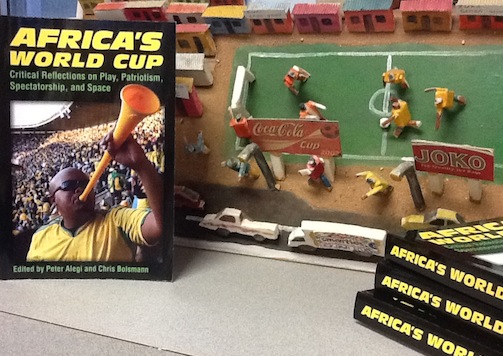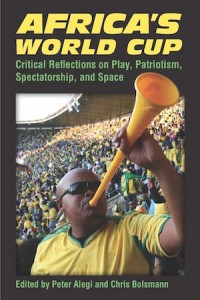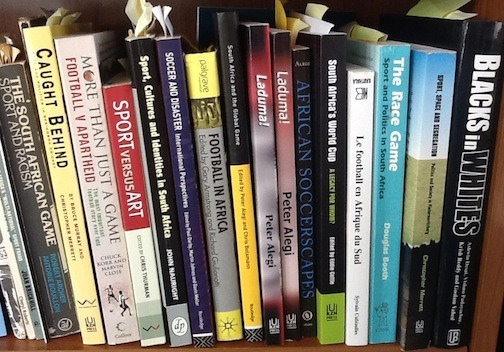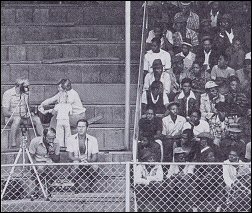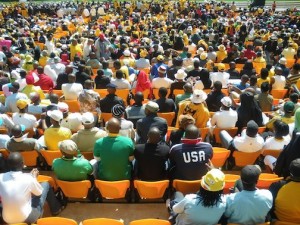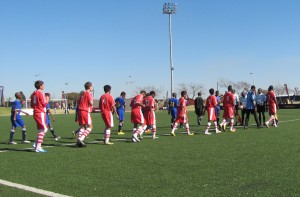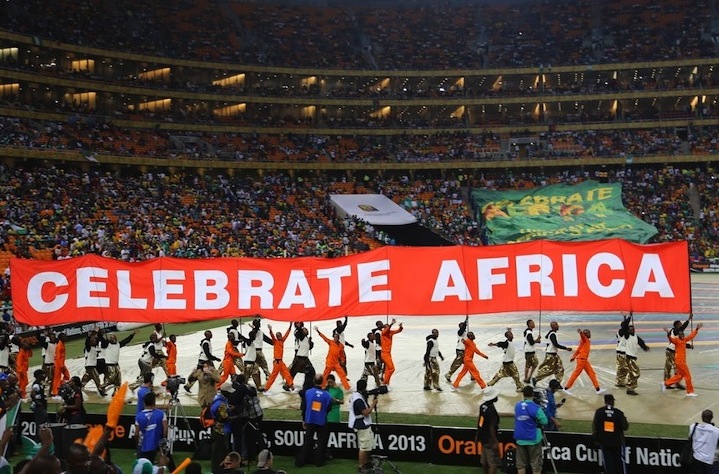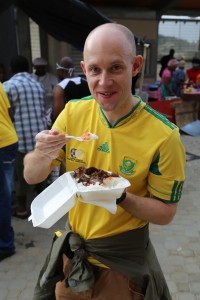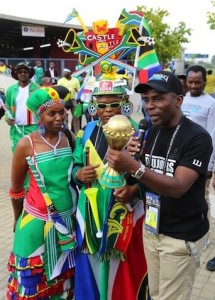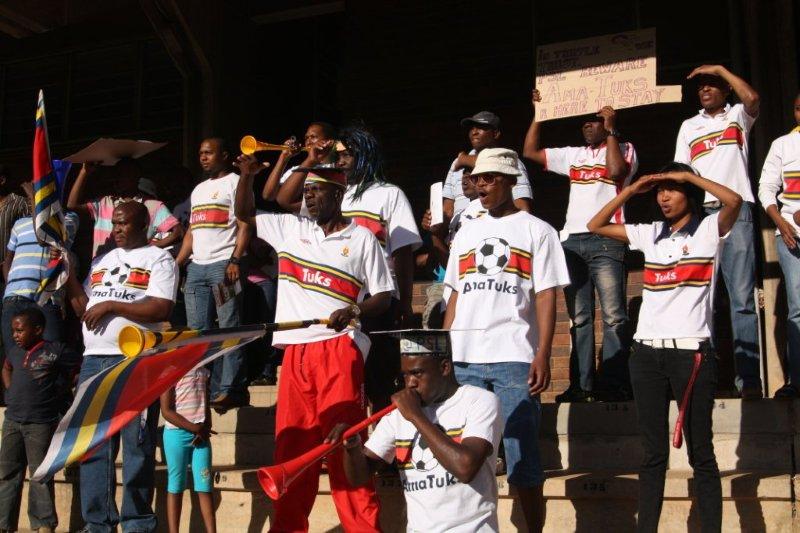Recently, I spoke with Liz Timbs, the creator of Imbiza 1.0: A Digital Repository of the 2010 World Cup in South Africa. Imbiza (http://imbiza.matrix.msu.edu) is an open-access web-based project that uses a highly modified theme on a WordPress framework. Objects contained in Imbiza were catalogued and preserved using KORA, the digital repository and publishing platform developed by Matrix at MSU. Liz is a Cultural Heritage Informatics Fellow and a PhD candidate in African history at Michigan State University. She is a regular contributor to Football Is Coming Home. Follow her on Twitter at @tizlimbs.
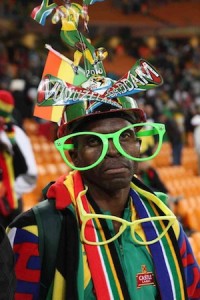 Why do we need a Digital Repository on the 2010 World Cup?
Why do we need a Digital Repository on the 2010 World Cup?
I began to develop this idea after an October 2013 session of the Football Scholars Forum on the edited volume, Africa’s World Cup: Critical Reflections on Play, Patriotism, Spectatorship, and Space. During the online discussion, the conversation turned to ways of integrating academically-oriented essays like those in Africa’s World Cup with web-based images, videos, and texts produced by non-specialists for a general audience. While this conversation was framed in terms of what could be done for the upcoming World Cup in Brazil, I began to wonder how a project like the one being bandied about by these journalists and scholars could be used to help us further understand the 2010 World Cup in South Africa. That’s really where the idea for Imbiza came from.
This repository serves several complementary purposes. First, it provides an opportunity to think about the 2010 tournament in advance of the upcoming World Cup, challenging us to think about how the content created for Brazil 2014 will be preserved as well as the types of content that specialists should be consciously working to either create or capture. Second, I believe that combining African Studies, sport history, and digital humanities—often perceived as “niche” disciplines—challenges conventional conceptions about knowledge production and what kind of scholarship counts. Finally, many of the images and videos in this digital archive illustrate a very important part of the 2010 tournament: the hope it generated among international fans that their teams would go far in the competition and among South Africans that the World Cup would change the image of their nation around the world.
What was your initial vision for the project and why did it change from inception to v. 1.0?
My initial vision for the project was to build a comprehensive digital archive of the World Cup, combining textual, audiovisual, and digital sources. As I started the collection process, I really underestimated the amount of material that I would find. In addition to the submissions I received from my contributors, the textual sources that I uncovered were a bit overwhelming and I had to recalibrate my expectations. With this in mind, I decided to limit my focus to just the stadiums and fan parks. An added benefit of this approach was that it provided a way to use these physical sites as prisms through which to analyze some broader themes around the tournament.
Even with some constraints, however, arranging everything I had into a coherent project was still a daunting task. As I re-evaluated what I collected, I decided for version 1.0 to present only photos and videos that contributors shared with me. In other words, I left out much of the publicly available multimedia record on the web. The audiovisual materials produced by my contributors are so emotive and rich that I knew using these sources would result in a dynamic presentation that would set a high standard for the next phase.
Tell us about the process. How did you set out to collect the audio-visual materials and what was that experience like?
The process, like the project itself, really originated in the Football Scholars Forum. My first step after conceptualizing Imbiza was to reach out on Twitter, asking friends and colleagues (and friends of friends and colleagues) to either contribute their own content or alert others who might have relevant materials to the project. The majority of the project’s content was collected this way, integrating content from Peter Alegi (@futbolprof), Chris Bolsmann (@chrisbolsmann), Marc Fletcher (@marcfletcher1), Duane Jethro (@materialpasts), Kevin Kalinowski, David Patrick Lane (@LosCharruas), Jay Meyer, and Mark Moll. Later, I also made a call for material on various academic listservs and even to some friends on Facebook. That’s why I refer to this project as “digital, from top to bottom.” This collaborative process has been really inspiring and productive for me and I look forward to continue to foster relationships like this for Imbiza and other future projects.
After I received these materials, I began to catalog all of them through KORA. This was probably the most time-consuming task; making entries for each individual object, arranging them by category, and beginning to conceptualize how they could all be grouped together as the site progressed. From there, I started to make mock-ups of the final website (which probably changed five times before I got to the current design). Then, I began programming the site itself, modifying the WordPress theme, and rolling with the (numerous) technical difficulties, eventually getting to what you see on the site today. There’s still a lot of work to be done, but it’s already come a long way!
Tell us about some of your favorite digital World Cup sources. What was most eye-opening about them?
I have two favorite sets of sources from this version of the project. I was probably the most excited about Chris Bolsmann’s photos because a lot of them haven’t been made publicly available before (except a few that were published in Africa’s World Cup). They really capture the different nations’ fan cultures, the atmosphere in the stadiums, and some of the art exhibitions that happened around the tournament, like the Halakasha! exhibit in Johannesburg. Chris’s photos are also quite artistic in their own right. The photo of a fan after Ghana’s loss to Uruguay (see above) is so compelling, juxtaposing the joy of his makarapa, giant glasses, and jersey with the utterly disappointed look on his face.
On the other side of things, I’ve really loved delving into David Patrick Lane’s videos. His interviews with locals, his Gizza series with fans from different countries, and his footage of various Uruguay matches opened my eyes to the tournament in new ways. His interview with Amos, a sanitation worker in Johannesburg, is probably my favorite video in the entire collection. It always makes me smile and, I think, says a lot about the Pan-Africanist sentiment at the tournament. (Shame that Davy’s laptop was stolen towards the end of the tournament. It would have been great to see him do some post-tournament interviews and capture some of the frenzy of Ghana v. Uruguay.)
You called this project “Imbiza 1.0.” What can we expect in version 2.0?
Version 2.0 will include more photos and videos from the 2010 World Cup, as well as a lot of textual sources that I gathered in the collection process. I have a PDF of the entire 2010 Bid Book that I hope to break into smaller segments for easier consumption, as well as a huge number of newspaper articles that I found online. Duane Jethro has provided me with some very exciting and original sources on vuvuzelas that will add a really interesting layer to the next version.
You can also expect the integration of some sources on the upcoming World Cup in Brazil as well as some comparative analysis. I am working to set up a Twitter archive to collect tweets for the 2014 World Cup and I am also beginning to reach out to Brazil experts for sources and ideas. I hope to set up a second World Cup archive for Brazil, tentatively titled Legado; but this second project will depend on the progress I am able to make on Imbiza in the coming months.
